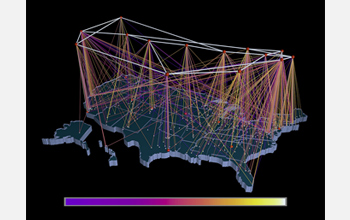

Press Release 08-112
The Day the World Changed

July 1 marks 20th anniversary of the development of the modern Internet
July 1, 2008
"The NSFNET Backbone has reached a state where we would like to more officially let operational traffic on." Twenty years ago, a network engineer named Hans-Werner Braun started an e-mail message to the users of the National Science Foundation's (NSF) fledgling NSFNET project with that sentence to announce that the network's main lines, or backbone, had been upgraded. Although they received little notice at the time, those simple words announced the birth of the modern Internet. NSFNET was created by NSF a few years earlier in an attempt to create a computer network similar to the Department of Defense's ARPANET. While this program had developed many of the tools and protocols that eventually shaped the Internet, it was largely limited to DoD-sponsored research. In the early 1980s, NSF began creating NSFNET to be a network open to all users that would also connect regional computer networks around the country. (For a more complete history of how NSFNET propelled the Internet from a DoD project to a world-wide phenomenon, check out a special report on the project at http://www.nsf.gov/news/special_reports/nsf-net/.) The responsibility to create NSFNET was awarded to a team made of MCI, IBM and a computer networking technology consortium of Michigan universities called MERIT Networks, and they soon had an unprecedented technical challenge on their hands. When the original six-node, 56 kilobits-per-second NSFNET backbone went into operation in 1986, NSF made the fateful decision to allow any academic, governmental or commercial entity to hook up to this network of networks. Within a few weeks of going online, traffic on the new network began doubling every few weeks. The network's backbone of core 56 kilobits-per-second connections were considered fast, but they were not fast enough to satisfy the demands of all the new users who were coming online. George Strawn, now NSF's chief information officer, was in charge of the campus network at Iowa State University at the time. He described how network users, frustrated by the congested network, would "bang on my desk, ‘the network is too slow. I can't use the thing.''' Braun was the principle investigator at MERIT for the NSFNET project, and he and MERIT's president at the time, Eric Aupperle, were tasked with working to meet this challenge. After collaborating with the other project team members and network users to address the congestion problem, it soon became clear that the network backbone needed an upgrade. The MERIT team decided on an audacious goal--to upgrade the backbone to a T1 level of speed, or 1.544 megabits-per-second, almost 28 times faster than the existing network. Program managers at NSF decided the upgrade needed to happen as soon as possible, and set July 1, 1988 as the completion date. The other program partners, according to Braun, were skeptical. During discussions with the telecom teammates about the planned upgrade, "MCI thought we were pretty crazy [about wanting a] 1.5 megabits-per-second capacity that was not channeled into 56-kilobit per-second circuits," he said in an interview last year. Despite the skepticism, through long hours and hard work, the partners met the challenge and completed the upgrade a day early on June 30, 1988, allowing Braun to send out his e-mail message that evening announcing that the new backbone was ready for traffic. The upgrade was a success, and traffic congestion on NSFNET was relieved, at least for awhile. "The minute the T1 backbone went into service, all of a sudden, the complaints from our faculty at Iowa State stopped," said Strawn. Traffic on the network continued to skyrocket, however, as more and more commercial users came online. Within a few years, private network providers were able to accommodate this traffic and NSFNET was decommissioned in 1995. By that point in time, however, 'the Internet' was a household word--and in use by millions of those households. Though its story is somewhat overlooked by history, NSFNET is generally accepted as the progenitor of the modern Internet as we know it today--a massive, global network that has made our world smaller and changed our lives in countless ways. And it all took off after that simple e-mail 20 years ago tomorrow. -NSF-

Media Contacts
Dana W. Cruikshank, NSF (703) 292-8070 dcruiksh@nsf.gov
Related Websites
Special Report: NSF and the Birth of the Internet: http://www.nsf.gov/news/special_reports/nsf-net/

The National Science Foundation (NSF) is an independent federal agency that supports fundamental research and education across all fields of science and engineering, with an annual budget of $6.06 billion. NSF funds reach all 50 states through grants to over 1,900 universities and institutions. Each year, NSF receives about 45,000 competitive requests for funding, and makes over 11,500 new funding awards. NSF also awards over $400 million in professional and service contracts yearly.
 Get News Updates by Email Get News Updates by Email
Useful NSF Web Sites:
NSF Home Page: http://www.nsf.gov
NSF News: http://www.nsf.gov/news/
For the News Media: http://www.nsf.gov/news/newsroom.jsp
Science and Engineering Statistics: http://www.nsf.gov/statistics/
Awards Searches: http://www.nsf.gov/awardsearch/
|


